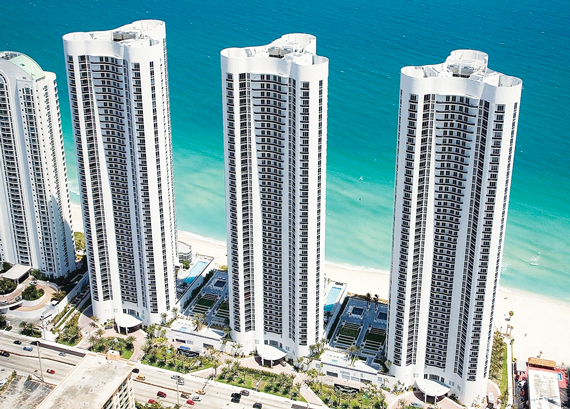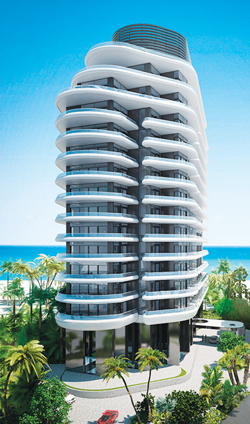Trending
See you in court

Business may be slow for realtors and developers, but it’s booming for Gary Brown, a Miami attorney with Arnstein & Lehr specializing in suing builders for construction defects. “I’ve got about half a dozen cases I’m currently working on,” Brown recently told The Real Deal. “As more projects get completed this year, I don’t expect a shortage of construction defect lawsuits in 2017 and 2018.”
Indeed, the slowdown in the once-red-hot luxury condo market has created a post-boom flurry of litigation over construction defects between attorneys like Brown, who represent condo associations, and their adversaries representing developers, architects, general contractors, engineers and subcontractors. The activity has been fueled by the glut of buildings that developers rushed to get finished before the boom phase of the most recent cycle grinded to a halt, as well as by buyers feeling remorse over having signed contracts at the top of the market.
From condominium buildings built more than 10 years ago, like the Trump Towers in Sunny Isles Beach, to recently constructed glass towers like Faena House in Miami Beach, dissatisfied unit owners are turning to the courts to force developers and construction companies to fix alleged errors or pay up.
“The increased number of lawsuits should be directly reflective of the increased number of buildings,” Gil Dezer, developer of Trump Towers I, II and III, told TRD. “So the fact that many buildings were built [in the last decade], more than ever before, is the reason you are seeing more lawsuits than ever before.”
Under Florida law, condo associations and owners must go through a 120-day mediation process with a developer and its contractors once construction defects are identified after a building has been delivered. Once the developer or contractor receives a notice of defects, they typically notify their insurance carriers to pay for their own experts and attorneys to investigate claims submitted by an association or owner.
After state courts were inundated with construction defect lawsuits in 2009, following the real estate market crash, the Florida Legislature set up the mediation process. “It was designed to curtail litigation we had in the condo sector years ago,” Brown said. “The process allows the parties to resolve their disputes before going to court.”
 However, a 2015 court case in which construction company Altman Contractors sued its insurance carrier threw a monkey wrench into the process. The insurer, Crum & Foster, won a ruling in Miami federal court that the notice of claim filed by an association or owner is not a lawsuit under state law, so therefore an insurance company is not required to defend the contractors, including covering payments for attorney and expert fees. The 11th U.S. Circuit Court of Appeals, which is hearing an appeal by Altman, has asked the Florida Supreme Court to rule on whether the defect notice process can be defined as a lawsuit under a comprehensive general liability policy.
However, a 2015 court case in which construction company Altman Contractors sued its insurance carrier threw a monkey wrench into the process. The insurer, Crum & Foster, won a ruling in Miami federal court that the notice of claim filed by an association or owner is not a lawsuit under state law, so therefore an insurance company is not required to defend the contractors, including covering payments for attorney and expert fees. The 11th U.S. Circuit Court of Appeals, which is hearing an appeal by Altman, has asked the Florida Supreme Court to rule on whether the defect notice process can be defined as a lawsuit under a comprehensive general liability policy.
If the appeal is denied, even more cases are going to end up in court, says David Haber, a partner at Haber Slade, who won a $22.5 million settlement in September for the San Matera Condominium Association. After six years of litigation, Kolter Signature Homes and its contractors agreed to pay the money in order to address numerous construction defects at the San Matera at the Gardens development in West Palm Beach.
“The problem with these very large projects is that very few developers want to settle the claims,” Haber says. “They force you into litigation. There are going to be a lot more lawsuits in the next two to five years.”
During the last six months of 2016, lawsuits have been filed against the developers of some of the ritziest condo towers built in the most recent cycle. In August and December of last year, owners of three units at the Chateau Beach Residences filed separate construction defect lawsuits against the developer, the general contractor and a subcontractor of the Sunny Isles Beach luxury condo tower. The plaintiffs are seeking millions in damages resulting from a gas explosion on the top floor of the 34-story building that injured six people in October 2015, one month after Chateau Beach was completed.
The New York-based developers of the Marquis Miami condo tower in downtown Miami were also hit with a construction defect lawsuit this past September. The building’s condo association accused Shaya Boymelgreen and Lev Leviev, as well as the construction companies they hired, of failing to fix alleged defects found in the roof, structural components, post-tension cable assemblies, the plumbing and the fire and life-safety system, among other accusations.
In October, a Russian family sued the Trump Group (no relation to President Donald Trump) and general contractor Coastal Construction for alleged defects in their $7 million apartment in the Mansions at Acqualina in Sunny Isles Beach, which was completed in 2015. According to the complaint, the unit was damaged due to water coming into two bedrooms from a poorly installed window and a faulty fire sprinkler system.
Unit owners at the Epic Residences Miami and Faena House in Miami Beach also filed construction defect lawsuits in the latter part of 2016.

Alleged construction defects are the subject of a lawsuit at Faena House in Miami Beach.
While the Eleventh Judicial Circuit Court of Miami-Dade has not compiled statistics on the number of construction defect lawsuits, the court system recently expanded its Complex Business Litigation Division to accommodate the looming caseload. The division, which handled the tsunami of foreclosure litigation between 2010 and 2014, also went from one to four judges specifically assigned to construction defect cases, according to an administrative order that went into effect on Jan. 2.
“That was an excellent decision by the court system,” Haber says. “By their very nature, construction defect cases are complex, with multiple parties, multiple lawyers and multiple experts.”
Richard Morgan, a shareholder with the law firm Buchanan Ingersoll Rooney, said construction defect cases require judges who can spend a lot of time reviewing thousands of hours of testimony and evidence. “For a judge in the general circuit division, it is difficult to get engaged in all these issues,” Morgan said. “We had a major case that involved 40 different disciplines from the roofing to the plumbing to aesthetics.”
Lawyers affirmed that the increase in lawsuits is a byproduct of builders’ looking to cash in as quickly as possible during the boom part of the real estate cycle. “Because Florida is so boom-and-bust, there is a very compressed cycle for developers to get their plans and buildings off the ground before foreign currencies go down and people don’t want to buy anymore,” Haber said. “The more you compress time and push people harder to finish a job, the harder it is to get good workmanship.”
Michael Kurzman, a partner at Weiss Serota Helfman Cole & Bierman, said that during a construction boom, qualified labor is in such high demand that some general contractors and subcontractors cannot find skilled workers. “The labor pool is only so big, so companies are stealing quality laborers from one another,” Kurzman said. “They hire people that don’t get proper training when they are building like crazy. As an end result, some projects suffer because of the shortage of trained labor.”
In the past six months, Kurzman said he has experienced a significant increase in his construction defect claims workload. “I am working every day,” he said. “I can’t keep up.”
He said developers could easily avoid construction defect lawsuits by hiring an engineering firm that oversees construction. “So when you turn it over to the association, there will be very few issues the condo board can complain about,” Kurzman said, adding: “But some developers don’t want to spend the money because the engineers aren’t cheap.”
Of course, developers have a different take. Dezer, whose company was sued in April 2016 over alleged shoddy construction work at Trump Towers I, II, and III, said lawyers and engineers hired by condo associations to go after builders for construction defects never want to see a case go away. “They need to prove their value, so they convince condo boards to continue fighting instead of settling during the mediation process,” Dezer says. “They want to be able to continue billing their clients.” Dezer also argued that engineers hired by condo associations are theorists with little hands-on experience in condo construction.
Alex Lastra, president of the Latin Builders Association, said sometimes condo owners resort to construction defect lawsuits to extract money from developers to offset falling prices for their units when the cycle slows down and a glut of inventory exists.
“As the market tightens, you tend to see more of these lawsuits,” Lastra said. “When an investor is not sitting on as much equity on a unit, they try to find someone who is at fault for that. They reach out and use the construction defect lawsuit as a crutch.”
Developers are not looking to get caught up in litigation over construction defects, and would prefer to just solve any legitimate issues, Lastra said. “A majority of developers, when presented with a true defect, will always want to go in and get it resolved.”




